|
|
|
Return of the Copperhead |
|
I haven't decided what to do with this page yet, so I parked it here for now. |
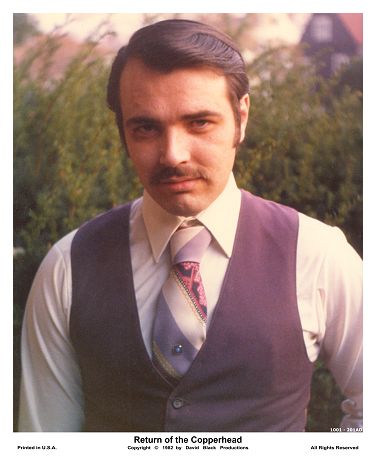
|
Blackie Seymour was my friend and business partner. I hadn't visited him in about six years and recently I was thinking about looking him up again and thought hey, why not use this Internet thing to see if I can find out what's new. Sadly, a Google search found that he had passed away last April 30, 2011. That same search also revealed that there is some misinformation around concerning the movie serial "Return of the Copperhead." There are those who claim to know things that they really don't. I am not one of those people because, you see, ROTC was a "David Black Production" and I'm David. I'll tell you the whole story, or at least most of it, but it's gonna take a while to write it all down. I'll be doing it a little at a time but I wanted to get started so that I have an incentive to finish it. If I waited to put this out there until I had everything just right then I'd never finish. There are things I remember as I'm writing about other things. There are a million details but some of them matter and some don't. I'm writing about what I know and largely about what I did but don't get the idea that I think everything was all about me, or even just me and Blackie. There were many others who made important and valuable off-camera contributions, especially Danny and Jane but others besides. I didn't set out to write this page. I have even less interest in writing my autobiography than you have in reading it. I wish I'd done this years ago when Blackie was around to speak for himself. |
|
I suppose that for some the bottom line is that it never emerged from post-production and so was never released. If that's all that matters to you then that's okay with me, you can stop reading here and go away. If you're interested in knowing the true story and the reasons for it, stick around. Some of the statements that I find most annoying were posted on message boards as much as ten years ago, so it's a little late for me to be getting excited about 'em but, since I never previously had cause to google ROTC, I'm now seeing them for the first time. Perhaps I'll calm down after a while. It may be that what bothers me most is that some people think they can summarize the whole thing in a few words. "I heard that his 8 year old son operated the camera while he acted!" Really? There's Blackie and an 8 year old and that's it? I suppose that guy might have "heard" this from Wikipedia: "In the 1970s, serial fan Blackie Seymour allegedly shot a complete 12 chapter serial called The Return of the Copperhead. Mr. Seymour's only child, who operated the camera at the age of 8..." ROTC was shot in the 1980s, not the 1970s, it was 15 chapters, not 12 chapters and, well... Or this delight: "I happen to be familiar with the Return of the Copperhead. Blackie Seymour wrote a script, shot some publicity stills and shopped this project around for investors. He even had a stuntman who offered to do professional stunts. Nothing ever came of this project." Really? You "happen to be familiar?" Wow. |
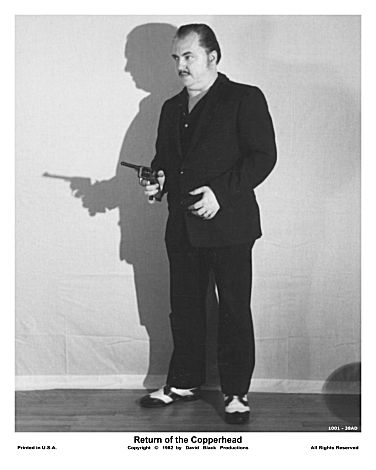
|
|
"Return of the Copperhead" was written and shot as a fifteen chapter serial of 23+ minutes per chapter. Even subtracting titles, stock footage and a budget chapter that's about four and a half hours of finished footage to be shot. Think three 90 minute movies for scale. Is anyone familiar with the term shooting ratio? Ours was incredibly low, but way more than 1:1. Ever look at the end credits for a movie? It lists all the jobs that nobody wants to do just for the glory of an end credit. Do you think studios pay all those people but don't actually need them? Do you think that if you can't afford to pay anyone those jobs don't need to get done anyway? Most movies aren't shot from a script, they're produced from a script breakdown. (Yes, in the movie business Producer is a real job, or used to be.) A television series is filmed one episode at a time. A movie serial shoots all of the scenes at a given location at (roughly) the same time. Every location has to be accounted for, all of the scenes to be shot, all the actors needed, all the props, the costumes and wardrobe changes, equipment, behind camera personnel (or at least a list of jobs), scripts (or sides) available, set dressing needed, permissions needed, and more. Every shot in every scene has to be listed, plus cover shots, pickups and alternates. Preparing a script breakdown for ROTC took more than a month of full-time work. Everything has to check and double check. It takes a lot of doing to persuade a city and its merchants and businesses to close off a street downtown while you film car chases and kidnappings and gun battles (not to mention the police; we'll talk about that later) and you don't want the nightmare of persuading them to do it again 'cause you forgot something. |
|
This page and all pages on this website are Copyright © 2011 by David Leary |
|
Anyone who wants to can email me: |
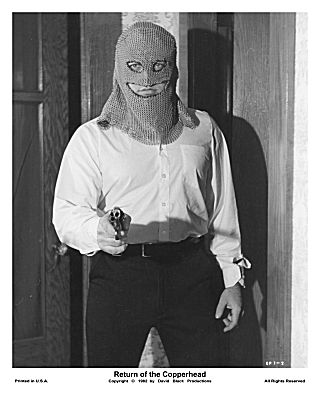
Michael Vaughn as |
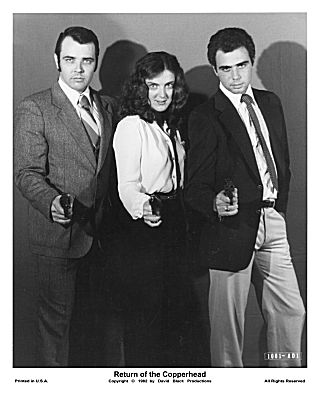
Michael Vaughn as "Bob Wayne" |
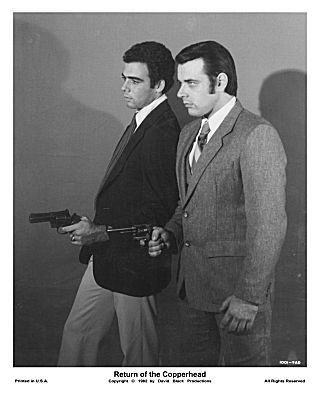
Danny Amorello as "Jeff Stevens" |
|
|
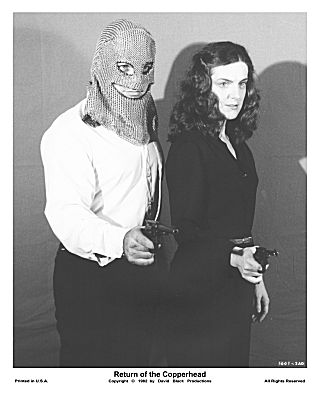
Michael Vaughn as "The Copperhead" |
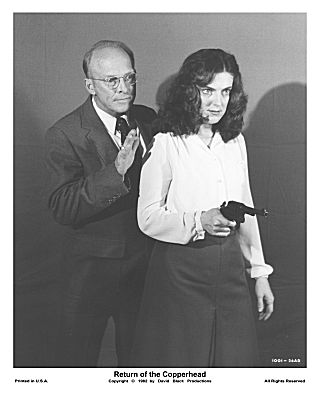
Tim Waite as "Professor Parker" |
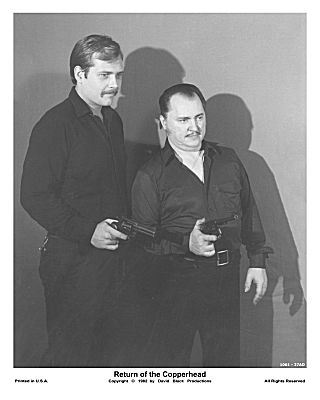
The Raven's henchmen. Michael Stone as |
|
|
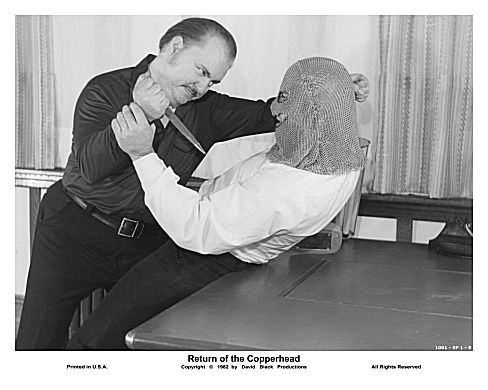
Blackie Seymour as spearhead heavy "Corey" |
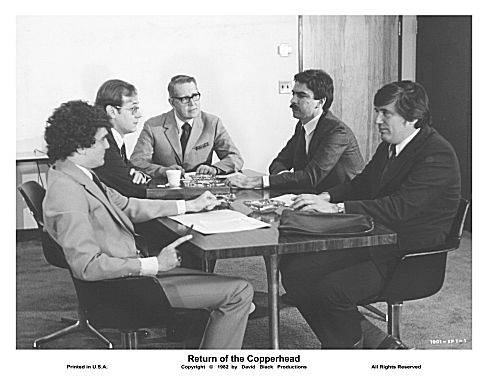
Serial historian Jim Shoenberger portrays "Maxwell," |
|
|
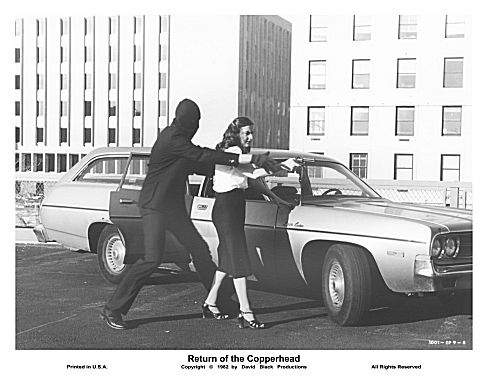
"The Raven" interrupts Joan Parker's rescue effort. |
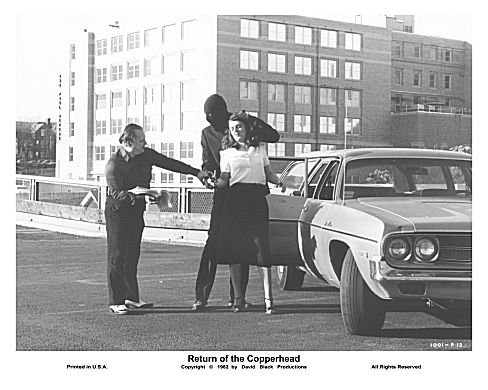
Director Blackie Seymour (note the trademark black and white shoes) |
|
I was originally going to be a bit more cagey about "The Raven's" identity (-?-) but at this point I don't suppose it's much of a spoiler. Bill Kilmer was one of the few actors in the serial who actually earned a living from acting, mostly on stage. He was great in every role I ever saw him in and perfect as "The Raven." Bill was a good guy to work with and an inspiration to all around him. Of course the picture is posed. Blackie didn't need to actually carry the script while providing direction. The script is just a prop; it's a publicity shot. Bill probably wasn't wearing the sweaty hood when the motion picture camera wasn't rolling, either. The numbering on the stills roughly follows Universal's practice rather than Republic's. "AD" shots (advertising) are virtually always posed, usually shot in a studio though sometimes one might take advantage of a location. Their purpose is to get portrait quality pictures of the actors. Some of the poses or interactions may have nothing to do with the actual story. "P" shots (publicity) are usually taken on location while filming though not necessarily while the motion picture camera is rolling. They may be candids of the actors lounging around the set or "behind the scenes" looks at the crew and other activities, or they may be more or less posed shots of the director or stunt coordinator or others where a picture of them actually doing their job might be somewhat less photogenic. They were there, they were doing the job, it just doesn't necessarily look exactly like this. Episode ("EP") stills are from scenes actually in the movie. They may be posed (re-staged) so that the still camera can get a better placement, or they may be photos of on set rehearsals prior to filming (when a still photographer moving around is less distracting) or they may be from the actual take (1001-EP 9-8 is from the actual take) though necessarily from a more or less different perspective than the motion picture camera, but in all cases they represent action that's actually in the movie. Incidentally, the still photography has an even higher shooting ratio than the movie. There are many pictures taken for every one that makes it into the photo set. And there are hundreds more of location scouting, prop placement, lighting tests and other things that never get into the movie still set. Even with the still photographer(s) donating time (working for free) the budget for still photography is in the thousands. And at that the job was barely adequately done. The thing about one person "wearing multiple hats" is that when each of the "hats" represents a real job then you can only wear them one at a time. When the still photographer is also the Director of Photography (aka cinematographer) then adequately arranging lighting for scenes takes precedence over adequate still photography. The need to prioritize affects all of the jobs to be done. Sometimes there is an alternate person who can cover for a time but often not since that alternate is likely wearing one of their own "multiple hats" at any given time. For those familiar with Worcester, Massachusetts this was filmed on the roof of the Pearl-Elm garage (about 5 or 6 stories up). There's an office building that connects to the roof of the garage and in the story Bob Wayne's office and the State Investigating Committee offices are located in that building, so a lot of action takes place on the garage roof. The actual location used for Wayne's office was next door in the front of the Commerce Building, while the State Investigating Committee's conference room was in the Chamber of Commerce suite on Front Street. |
_488x390_.jpg)
© 2011 David Black Productions Bancroft Tower circa 1969 when it still had the WW II era air raid siren on top. |
_488x390_.jpg)
© 2011 David Black Productions Another angle showing that the air raid siren can be eliminated from the shot if necessary. |
|
No setting is more iconic to the creation of ROTC than the Bancroft Tower. Once an obscure monument in a mostly neglected park, today it's on the National Register of Historic Places, the random white painted bolders have been replaced with neat concrete-filled pipes and there are plaques and whatnot. Even those who knew of it then mostly knew little about it but today anyone can google it and think they know something. As a cheap but dramatic set it was irresistable and the inevitable headquarters for the brains heavy, who was then named appropriately to the set. In 1969 when we were writing the first draft of the script we made some photos for reference. They were not intended for publication so were cheaply printed, some were cut and pasted together so that Blackie could block out camera angles, and in general were handled roughly. I've made little attempt to clean up the ones that I'll show here. |
_320x400_.jpg)
© 2011 David Black Productions |
_320x400_.jpg)
© 2011 David Black Productions |
Yes, the tower is five or six degrees off vertical (in the photo, that is, not really). These were quick and dirty prints just to get the layout. Never intended for posterity. Sometime between 1969 and 1981 the air raid siren was removed. Blackie's note on the back. David rarely refers to himself in the third person, and almost never as "Dave". Later, Dave climbed back down to get the camera and took a series of shots that we could piece together for a panoramic view of the main roof. Cheaper than a helicopter but cooler than measuring and drawing a map. Last time Dave saw that panorama it was on the wall in Blackie's office on Belmont Street. |
|
Certainly a lot has changed since those days. Digital photography is a lot cheaper, so younger people might not understand when I reference the cost of photography. This was back in the day of chemicals and darkrooms and paper coated with emulsion. We had phone booths back then, too, and used carbon paper in our typewriters. The world was different. You could stand on the parapet of a 60 foot tower and nobody worried about the legal liability or national security implications. That is, you could on a casual, unannounced visit. Once a location becomes a movie set that changes everything. Whether it's the Bancroft Tower or the Pearl-Elm Garage or the Worcester Airport or well, we'll get to others later, you have to have the legal right to be there because you need to have the legal right to exclude the general public, which means you need to request and receive permissions in writing, and writing always causes officials to ponder the issue of legal liability which is to say, insurance. One million dollars was the usual amount required although Amtrak decided they'd feel more comfortable with ten million. Fortunately for poor but honest filmmakers the short term premium is quite reasonable. Or was. Legal correspondence, consultations, visits to offices, negotiations of minutiae, scheduling, contingencies, indemnities, insurance, police presence, community relations, fees, access, releases, notices, etc. endless etc. are all part of making movies, though usually accomplished by more than a few people (remember those end credits). Not the glamorous part. The glamorous part would be the other two percent. And I used the phrase "a few people" rather than "a couple of guys" because I know that Jane and Danny (and some others) were instrumental in these matters, sometimes in ways I didn't know about because I was busy with other aspects. I'll have more, a lot more, to say about these things later. I'm beginning to realize that I'm writing a book here, though I suspected as much when I said "a little at a time." These are just the notes, not the final draft. Most people, even most movie fans, have no concept of the amount of effort expended to produce what they see (or not) on screen, and if it's an "amateur" film they think you just point a movie camera and go with the flow. We didn't have the money or the backing of a Hollywood studio but as a professional business venture we needed to deal with all of the things that any business has to deal with, such as Workmen's Compensation insurance and OSHA regulations, as well as all of the special movie related issues such as speeding the wrong way down one-way streets while firing handguns. It may be magic when you see it on screen but it takes a lot of unmagical work to get it there. Blackie and I both understood, from the beginning, what we were taking on. No complaints. Truth to tell we both took pride in our ability to do everything it took to get the job done. Which isn't to say that the two of us did it all. That wouldn't be nearly possible on a project of this magnitude. We were the beneficiaries of the help and support and labor of dozens of people, all of them uncompensated and mostly uncredited. |
|
This page, entire website and all content are copyright © 2012 by David Black Productions, David Leary and Daniel Amorello |
|
|